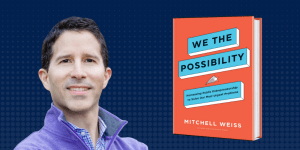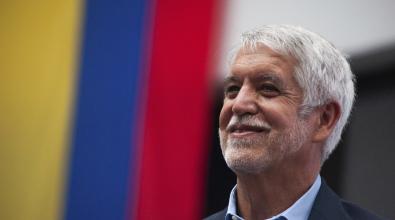The art of ‘possibility government’—and how it can help city leaders

The day after the 2013 Boston Marathon bombings, city leaders there acted fast to set up a new nonprofit to take in donations from all over the world and redirect the funds quickly to survivors and their families. Mitchell Weiss was chief of staff to then-Mayor Tom Menino at the time, and played a big role in the experiment.
It started with a one-sentence website linked to a PayPal account and grew out from there. Within 75 days, One Fund Boston had raised and distributed more than $60 million, far outpacing the results typical of local community foundations that normally set up these kinds of relief funds.
Weiss has told that story a number of times to mayors and senior city staff at sessions of the Bloomberg Harvard City Leadership Initiative. And he weaves it throughout his new book, “We The Possibility,” published last month by Harvard Business Review Press.
Weiss, now a Professor of Management Practice at Harvard Business School, uses that story, among others, to underscore governments’ capacity to solve big public problems. Making the most of that capacity, he writes, requires entrepreneurial thinking and skills—building blocks of what he calls “possibility government.” For city halls, that means opening up to new ideas, using experimental approaches to learn which ideas work, and scaling up the ones that do.
Bloomberg Cities caught up with Weiss to hear more about the book and what city leaders can take from it.
Bloomberg Cities: In the book, you call for a shift away from what you call “probability government” toward what you call “possibility government.” Explain what you mean.
Mitch Weiss: Probability government is the pursuit of programs and services by public leaders and their partners that will “probably” work but oftentimes lead to middling outcomes that aren’t really up to the task.
By contrast, possibility government is the pursuit of new programs and services by public leaders and their partners that, by virtue of their novelty, are unlikely to work—they only possibly might work. The recognition we need to face these days is that often the status quo is the dangerous choice. And whether it's pandemic preparations or job retraining or education, just doing what we've been doing isn't good enough.
How did the marathon bombing aftermath shape your thinking?
The lesson of the book is yes, government can start new things—if…. And the “if” is, if we're willing to try things that might only possibly work. And that’s going to take opening up to new ideas, being able to try those ideas, and being able to scale them eventually.
In every instance, the marathon experience has lessons for us about how you open up to new ideas, about how you look to users for their needs, about how you try things in these “minimally viable” ways—you know, just a PayPal account, and later, a Post Office box. You don't wait two weeks to get started.
[Get the latest innovation news from Bloomberg Cities! Subscribe to SPARK.]
What gets in the way of local leaders coming up with new ideas and how can they change that?
Oftentimes in government, we're experts in what we know, and we invite in other experts in that same thing. Which means we're picking people who are experts in the past. And what we need to do is find people who are going to be experts in the future. That means bringing in different types of people in terms of diversity of thought, opinion, and background to engender new ideas.
We don't always actually go to the user, the citizen themselves, and trust that they have some really good potential solutions to challenges that face them. We have to have faith that our neighbors do, in many cases, hold great solutions to the challenges facing our communities.
And then we have to recognize that bringing in new people, bringing in new voices, opening ourselves up—it's going to lead to a flood of ideas. So you need a process for sorting the good ideas from the bad ones, so you can get going on a few of them.
You write a lot about the need for city leaders to get comfortable with “experimenting in public.” What do you mean?
Experimenting in public becomes essential if we're going to build on all these new ideas. Oftentimes, what we do when there is uncertainty facing us about a new program or service, is we either don't do it at all, or we try to plan our way through that uncertainty. There is an alternate way to try to move through that uncertainty, and that is the way of entrepreneurship. It’s, frankly, the way of science. It’s to experiment our way through it, to try some things out in minimally risky ways, learn from them, and move on from there.
It’s a challenge, especially in public life, because most new things aren't going to succeed. And so failure looms large for public officials. Not being able to guarantee the public success feels fraught, and it is. But the strategy here is to use the method of hypothesis-driven entrepreneurship, or what Eric Ries calls Lean Startup, and build, measure, and learn your way through the uncertainty, recognizing that the status quo is often the riskiest choice.
[Read: Unleashing civil servants to innovate]
Explain what you mean by the status quo is often the riskiest choice.
There's an example in the book with Mayor Bill Peduto when he's allowing the testing of autonomous vehicles in Pittsburgh. And yes, allowing the testing of robot cars on streets has some peril. And in fact, we've seen fatal evidence of that in Arizona. But those public leaders, including Peduto, who are open to experimentation, have a very clear-eyed view of what's also dangerous, which is humans driving cars and killing people while texting or talking. It's not that we should race, eyes shut, into robot cars and let them have utterly free reign. But we have to find a way to experiment our way through, because the situation we have right now around mobility is also dangerous.
One of the tools of experimentation you discuss is the “minimally viable product.” What is that and how can local leaders take advantage of that concept?
Think about it like a prototype. It's not a complete version of whatever service you're going to offer. But there’s enough of it that you can test one or more of your uncertainties. And then, having resolved those, go on and test some more.
Let’s say you want to start an afterschool tutoring program to teach kids math after they play basketball. You can imagine a mayor having the program built—they hire the tutors, build a curriculum, secure the space, create a schedule—and maybe kids show up or maybe they don’t, maybe they learn or maybe they don’t.
There's another way to go about this. Ask: What’s your biggest uncertainty with this new program? And maybe it’s, you don’t know if the kids are going to want to come after basketball. You could put up a sheet with the name of the program and an email address in the locker rooms and say, “email here if you want to come for tutoring.” Now that's not the tutoring program—it's not even close to the tutoring program. But if you do it right, it will potentially answer the question: Are people interested in this before you build the whole thing? That little signup sheet is a very rudimentary minimally viable product.
It's important not to get hung up on the lingo. It just means maximize the amount of learning while spending the least amount of time and money. And you can oftentimes build partial programs, partial services, partial products that resolve uncertainties for you rather quickly. The learning is the point. And it is important when the mayor announces such a thing—to not promise success at the outset, but to promise learning.
[Read our explainer on prototyping]
Where should city leaders be looking for talent to scale this kind of work?
One place is inside their own city halls, agencies, and organizations. There are people hiding in the woodwork who have the interest and the skills to do idea generation, they’ve got the tools of experimentation and scaling. They’re just a little afraid that it’s not OK to suggest new ideas, and it’s not OK for them to try them if they don’t work. And so they need an invitation. We need to look inside government and draw people out.
And then I do think if we're going to get to scale, we also need to look outside and draw people in. There are customer-experience experts, user-interface experts, data scientists, data visualists, and product managers in the non-governmental world, in many cases in the private sector. We need to invite their skills and talents into government.
City leaders responded to the pandemic with a great deal of innovation. What does the experience of 2020 tell you about how these ideas can work in local government?
One thing I find hopeful is that so many mayors and other local leaders became instant entrepreneurs in the wake of COVID-19. They invented and co-invented with their communities and their other partners in all sorts of ways to keep people housed, to keep people fed, and to try to keep people healthy. And they didn’t need to be told to become more innovative per se. I mean, they've just been through a real-life crash course in adapting on the fly.
After all this is done, they may want to have a way of understanding how were we that inventive, and could we do that in other places? I hope the book gives them some language and even some tools for doing this again. That's what happened to me after the marathon bombings. I didn't know what public entrepreneurship was. I didn't know what possibility government was. I didn't know what Lean Startup was. But we were doing all those things. So I hope one of the lessons out of all this will be how to use possibility government to solve more things and do it with the sense of urgency we need.


